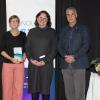December 2, 2004 - 4:00pm
American bullfrogs, a major pest threatening Vancouver Island’s biodiversity, are helping first-year biology students at Malaspina University-College in Nanaimo learn about science.
A shipment of about 100 bullfrogs – some the size of dinner plates – were recently culled from marshes and lakes in the Nanaimo area by local entrepreneur Nancy Ketchen, and delivered to laboratory freezers at Malaspina.
"We’ve been using American bullfrogs for dissection purposes for about five years, ever since they became a pest on the island," explained biology professor Allan Hawryzki. "This is how we train future doctors, nurses, pharmacists and biologists in anatomy. We use bullfrogs as a teaching tool."
Biology students have discovered whole birds, snakes, salamanders and mice inside the bullfrog’s stomachs, said biology professor Tim Goater.
"The bullfrogs eat whatever they can fit inside their large mouths," said Goater. "They are serious predators that threaten Vancouver Island’s biodiversity. These voracious creatures are invading our local ecosystem. They are capable of adversely impacting populations of native amphibian species, such as red-legged frogs and Pacific tree frogs."
Malaspina students have compiled five years worth of data about the American bullfrog’s anatomy, diet and parasites. The data is part of a long-term study to address important ecological questions about American bullfrogs, said Goater. "First year biology students really light up when they realize they are participating in a research program of local environmental relevance," he added.
Fourth year biology students, Nadine Simpson and Niels Bjornson, are conducting in-depth studies of American bullfrogs for their year-long Biology 491 independent research course. Simpson, supervised by Goater, is surveying parasites found in the bullfrog's internal organs. Bjornson, supervised by Hawryzki and Malaspina biology professor Allan Gibson, is studying the American bullfrog’s genetic make-up using DNA technology.
American bullfrogs, native to southern Ontario and Quebec, were imported to the West Coast in the 1930s by people looking to set up frog farms for commercial production of frogs legs, Simpson explained. When the enterprises failed, the frogs were dumped into local wetlands.
"They have been slowly colonizing into new areas," added Bjornson, and now their populations are out of control.
American bullfrogs invading the local ecosystem "have fewer parasites and no known predators" compared to bullfrogs found in their native habitat, said Simpson. "I’m investigating the theory that introduced species often become major pests," she said.
Bjornson is trying to determine if the Vancouver Island bullfrogs originate from back east or from smaller populations introduced years ago to the Victoria area.
Simpson and Bjornson said the hands-on research experience they are gaining at Malaspina will be beneficial when they apply to graduate school or seek employment. Both students will publicly present the results of their fourth year research projects at Malaspina University-College in March.
Hawryzki also supervised former Malaspina student Tanya Dunlop (formerly Giesbrecht) who also completed a major undergraduate research project on the American bullfrog. Dunlop’s research led to summer employment in 2002/2003 as the mid-island coordinator for the Bullfrog Control and Public Education Program funded by the Habitat Conservation Trust Fund.
Dunlop said American bullfrogs have been found in ponds and other marshy areas as far north as Campbell River. They are multiplying in Port Alberni, Parksville, Qualicum, Cowichan and Victoria. Once they have become established, the populations grow quickly. Adult bullfrogs can weigh up to 700 grams.
Dunlop helped train volunteers to participate in controlling bullfrog populations, and gave presentations to local stewardship groups. Bullfrogs are usually caught manually, she said, because the use of pesticides would be too dangerous for other local species.
-30-
Tags: In the Community





